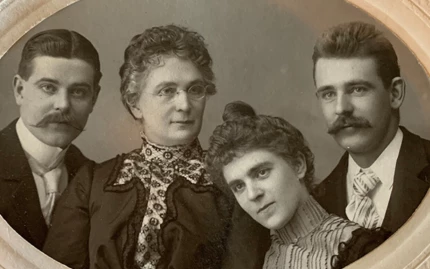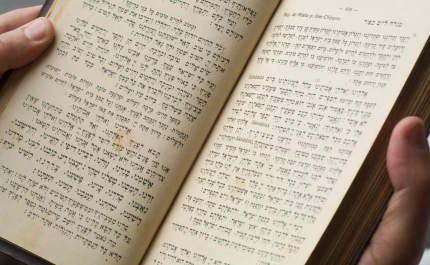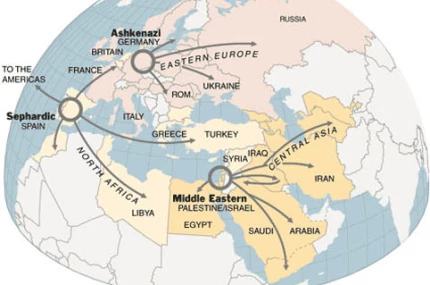Who are Ashkenazi Jews?
The Ashkenazi Jews represent a significant and influential group within the global Jewish community. Their historical journey, beginning from ancient times to their substantial presence in the modern world, illustrates a saga of migration, adaptation and survival against numerous challenges.
The designation “Ashkenazi” identifies a Jewish diaspora group that formed in the Holy Roman Empire towards the end of the first millennium. Their story is not only a chronicle of the endurance and resilience of a displaced people but also highlights their profound impact on the culture, sciences and economic development of every region they have settled in. If this topic interests you, you may also want to learn about the possibility of obtaining Israeli citizenship.
Origins and early history
The migration to Europe
The journey of the Ashkenazi jewish men to Europe marks a significant phase in their overall history. Archival evidence indicates that communities of this nationality began to establish themselves in the Rhineland as early as the 8th century, predominantly in urban centers such as Cologne. The initial waves of settlers were from Italy, followed by arrivals from the Levant, each group bringing their distinct religious practices and cultural norms, which they preserved amidst the Christian majority. Over the following centuries, these initial settlements expanded due to both voluntary migration and forced expulsions from other parts of Europe. As they moved eastward into Poland, Lithuania, and beyond, the Ashkenazi adapted to the local conditions, which shaped their religious practices and social organization.
By the medieval era, the Ashkenazi had solidified their status as a distinct ethnic group, but also as integral members of the local economies, often serving as merchants, money lenders, and tradesmen. The development of the Yiddish language, a fusion of Hebrew and German, alongside religious and cultural practices, helped solidify their identity as a cohesive community distinct from their Sephardic counterparts in Spain and Portugal.
Cultural identity and practices
The cultural identity is a vibrant tapestry woven with threads of ancient religious traditions, language, and adaptation to the various European societies they inhabited. Central to understanding Ashkenazi culture are the elements that distinguish it: language, literature, and religious customs, each fostering a strong sense of community and continuity among Ashkenazi populations.
Language and literature
Religious customs
Religion forms the cornerstone of Ashkenazi identity. The religious practices of the nation differ in certain aspects from their Sephardic counterparts, with variations in liturgical rites, pronunciation of Hebrew, and even dietary customs. Central to their religious life is the study of the Torah and the Talmud, with a strong emphasis on scholarly interpretation – a tradition that has produced a myriad of esteemed rabbis and scholars. This scholarly inclination also fostered a network of yeshivas, which became centers of learning and debate.
Key aspects of Ashkenazi religious customs include:
- Synagogue Architecture. Distinctive Eastern European styles with elaborate interiors.
- Prayer Services. Variations in melodies and liturgical readings.
- Kosher Laws. Specific Ashkenazi interpretations and traditions concerning food.
- Sabbath Observance. Unique family and community rituals on the Sabbath.
- High Holy Days. Special customs and prayers for Rosh Hashanah and Yom Kippur.
- Distinctive wedding customs, such as the breaking of a glass.
- Bar and Bat Mitzvahs. Celebrations marking the coming of age in the nation’s faith.
These customs not only reinforce religious faith but also strengthen communal bonds and continuity, ensuring that even in the diaspora, national traditions thrive and adapt. Through their religious practices, the Ashkenazi have maintained a robust cultural identity that has enabled them to navigate the complexities of living as a minority in diverse societies while preserving a connection to their ancestral heritage.
Genetic heritage and health
The genetic heritage of the nation is a topic of significant interest and importance, particularly in the fields of medical and genetic research. Due to their historical isolation and the effects of population bottlenecks, the Ashkenazi possess a unique genetic profile which has implications for both genetic diversity and health.
Genetic studies and findings
Extensive genetic studies have been conducted on populations, revealing a number of interesting characteristics. These studies have found that despite their wide dispersion, the Ashkenazi have maintained a higher level of genetic homogeneity than other dispersed ethnic groups. This closeness in genetic makeup is a result of centuries of relative isolation combined with the practices of marrying within the community.
Additionally, certain genetic markers are present at higher frequencies, which are otherwise rare in the global population, marking a distinct genetic signature that can be clearly identified and separated from other Jewish and non-Jewish populations.
Health implications
The unique genetic makeup of the Ashkenazi has significant health implications. While it provides researchers with valuable insights into genetic diseases and longevity, it also means a higher prevalence of certain inherited diseases within the community. These include:
- Tay-Sachs Disease. A fatal DNA disorder where harmful quantities of a fatty substance build up in tissues and nerve cells in the brain.
- BRCA1 and BRCA2 Genes. Mutations in these genes significantly increase the risk of breast and ovarian cancer.
- Gaucher’s Disease. A DNA disorder in which a type of fat (lipid) accumulates in cells and certain organs.
- Familial Dysautonomia. A disorder that affects the development and survival of certain nerve cells.
The awareness of these DNA risks has led to the development of specific community health initiatives, including genetic screening programs which are now commonly promoted within Ashkenazi communities, especially for couples planning to have children. These screenings help manage the prevalence of genetic disorders, providing crucial interventions that can mitigate health risks associated with these genetic traits.
Historical challenges and adaptations
The history of the nation is marked by significant challenges and remarkable resilience. From medieval persecutions to the horrors of the Holocaust, the Ashkenazi have faced and overcome adversity, adapting their traditions and maintaining their cultural identity against great odds.
Medieval persecutions and expulsions
The holocaust and its aftermath
The most devastating period in nation’s history was undoubtedly the Holocaust. During World War II, a significant portion of the Ashkenazi population in Europe was systematically exterminated by the Nazis and their collaborators. This genocide resulted in the loss of approximately six million people, decimating communities and wiping out centuries of cultural heritage.
The aftermath of the Holocaust saw the survivors facing the daunting task of rebuilding their lives. Many migrated to Israel or North America, where they played pivotal roles in establishing new, vibrant nation’s communities. In these new settings, they not only revived their cultural traditions but also integrated them with the local practices, thereby shaping the cultural landscapes of their new homes.
Modern ashkenazi jewish communities
Today, the nation has established thriving communities across the globe, particularly in North America and Israel. These modern communities not only preserve many aspects of traditional Ashkenazi Jewish culture but also reflect the dynamic adaptations they have made in new environments.
Ashkenazi jews in North America
Their impact on American culture is evident in the popularization of certain foods, contributions to the American labor movement, and involvement in civil rights advocacy. Furthermore, they have played a critical role in shaping American Jewish religious life, with major denominations such as Reform, Conservative, and Orthodox Judaism being heavily influenced by Ashkenazi traditions and interpretations.
Ashkenazi jews in Israel
This demographic constitutes a considerable segment of the population and has played a pivotal role in the nation’s establishment and growth. They were prominent in the leadership of the Zionist movement, which culminated in the creation of Israel in 1948. Over the subsequent decades, the Ashkenazi have continued to shape the political, cultural, and economic fabric of the nation. While they initially dominated the political and cultural institutions of Israel, modern times have seen a greater integration with other ethnic groups, contributing to a diverse and multifaceted Israeli society. Ashkenazi in Israel maintain their unique cultural identity while also embracing and mixing with the broader mosaic of Israeli cultures.
Contributions to global jewish culture
The contributions of the nation to global Jewish culture and the world at large are extensive and diverse. From culinary traditions to the arts and sciences, the influence of the Ashkenazi is deeply embedded in the fabric of Jewish life globally.
Cuisine and culinary traditions
Ashkenazi cuisine is renowned for its distinctive dishes, which have become staples in nation’s communities worldwide. Foods such as gefilte fish, matzo ball soup, bagels, and brisket are synonymous with Jewish culinary traditions and reflect the adaptation of the Ashkenazi to the climates and resources of Eastern Europe. These dishes were initially crafted from necessity and scarcity, utilizing ingredients available in colder climates and adhering to kosher laws.
Key dishes that highlight the rich culinary heritage include:
- Gefilte Fish. Poached fish patties or balls made typically from a mixture of ground deboned fish, often carp or pike.
- Matzo Ball Soup. A comforting broth with dumplings made from matzo meal, traditionally served during Passover.
- Dense, boiled-then-baked dough rings, often topped with seeds, which have become a global breakfast staple.
- Slow-cooked, tender beef that is a highlight of many holiday meals.
- Potato pancakes traditionally served during Hanukkah.
- A sweet, braided bread enjoyed on the Sabbath and other national holidays.
- A baked pudding or casserole, typically made from egg noodles or potatoes.
The global spread of these culinary traditions has also introduced them to non-Jewish populations, highlighting the cross-cultural influence of Ashkenazi food.
Music and arts
The klezmer music, with its emotional breadth and festive spirit, originated from the nation’s communities of Eastern Europe and has gained international acclaim, influencing a variety of music genres.
In classical music, Ashkenazi composers and performers like Gustav Mahler, Arnold Schoenberg, and Itzhak Perlman have been pivotal figures. Additionally, in visual arts, Ashkenazi artists such as Marc Chagall have blended traditional themes with modern artistic movements, creating works that resonate globally. In literature, Ashkenazi writers have profoundly impacted both Jewish and non-Jewish literary worlds. Authors like Franz Kafka, Saul Bellow, and Philip Roth have explored themes of identity, existential anxiety, and social critique that have universal appeal. Their works are considered crucial to understanding not only the Jewish experience but also the human condition.
an Israeli citizenship specialist



